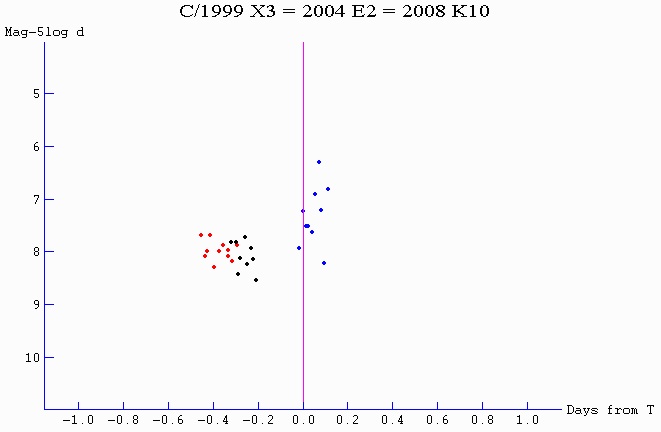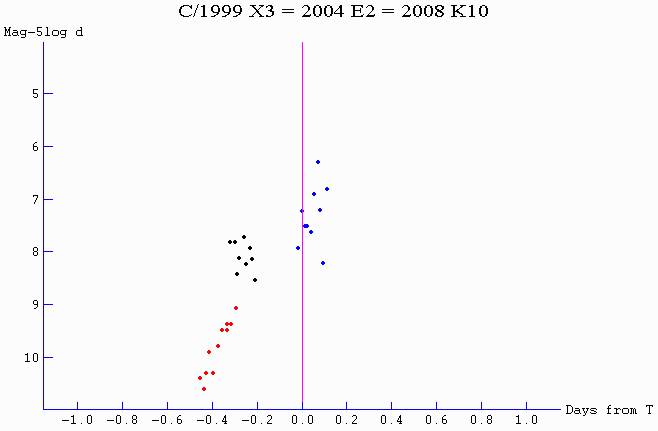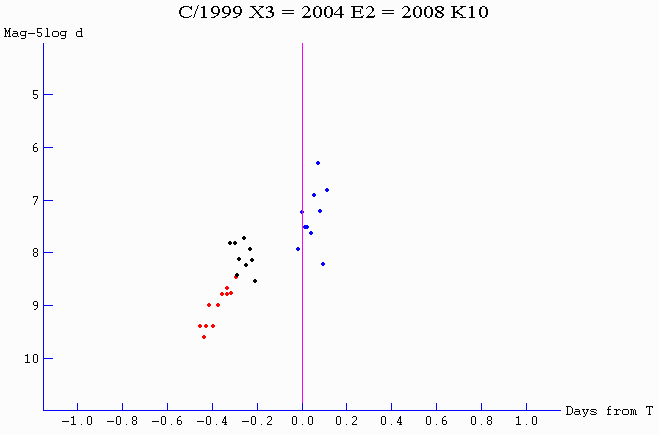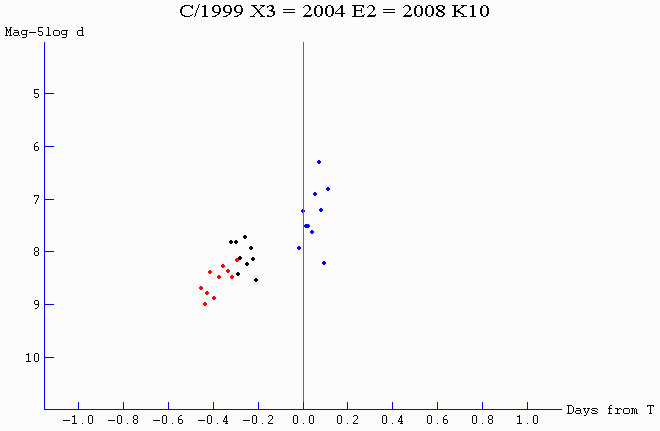C/1999 X3 = 2004 E2 =
2008 K10
C/2004 E2 was found by me on 2004 March 12 in realtime C2
images 08:06 - 10:30 UTC. It was confirmed by Karl Battams on
March 15 as SOHO-746. MPEC 2004-M42 was issued 2004 June 23 with
the official designation C/2004 E2 and these orbital elements:
| Designation |
T |
q |
e |
peri |
node |
incl |
L |
B |
| C/2004 E2 |
2004 Mar. 12.75 |
0.0132 |
1.0 |
116.09 |
322.84 |
11.67 |
79.4 |
+10.5 |
C/1999 X3 was found by Hua Su on 2006 May 26 in archival C2
images of 1999 December 12 13:31 - 16:06 UTC. Karl Battams noted:
"Hua Su's non-group comet looks good to me -- well done!! It
is fairly small and condensed, and looks to be brightening as it
reaches the edge of the image. I would guess at maybe mag 7.5 -
8.0. I think it is too small for C3, but I will check next
week.". Later (IAUC 8982, 2008 September 26) the comet was
described as "being near the limit of visibility in C2
images". The comet received SOHO number 1157 on May 31. MPEC
2006-L20 was issued 2006 June 02 with the official designation
C/1999 X3 and these orbital elements:
| Designation |
T |
q |
e |
peri |
node |
incl |
L |
B |
| C/1999 X3 |
1999 Dec. 12.67 |
0.0809 |
1.0 |
342.97 |
299.58 |
7.22 |
282.7 |
-2.1 |
Nothing indicated that both comets could be identical.
C/2008 K10 was found by me on 2008 May 31 in C2 images of May
30/31 23:06 - 00:54 UTC. It was confirmed by Karl Battams on June
13 as SOHO-1483 and described as "small and
stellar in appearance (mag 7-7.5, brightening as it left the C2
field-of-view but never appeared in C3)" (IAUC 8982,
2008 September 26). MPEC 2008-O16 was issued 2008 July 22 with
the official designation C/2008 K10 and these orbital elements:
| Designation |
T |
q |
e |
peri |
node |
incl |
L |
B |
| C/2008 K10 |
2008 May 31.23 |
0.0448 |
1.0 |
342.34 |
346.34 |
172.50 |
3.9 |
-2.3 |
After I had found C/2001 D1 = 2004 X7 = 2008 S2, I searched
for other unrecognized identities among the non-group comets. I
looked for comets with low inclinations, short observational arcs
and similar time intervalls between their perihelion passages. I
found C/199X3, 2004 E2 and 2008 K10 on September 24. The orbital
solution converged rapidly with small residuals (RMS = 9.6")
and I sent my solution to Brian Marsden at 21:11 UTC. Less than
two hours later MPEC 2008-S49 appeared with the identification
and these orbital elements:
| Designation |
T |
q |
e |
peri |
node |
incl |
L |
B |
| C/1999 X3 |
1999 Dec. 12.88 |
0.0522 |
0.9801 |
353.24 |
323.87 |
6.07 |
317.1 |
-0.7 |
| C/2004 E2 |
2004 Mar. 12.33 |
0.0484 |
0.9815 |
353.57 |
323.68 |
6.23 |
317.3 |
-0.7 |
| C/2008 K10 |
2008 May 31.33 |
0.0480 |
0.9816 |
353.61 |
323.66 |
6.26 |
317.3 |
-0.7 |
Brian Marsden noted that "The object passed 0.058 AU from
the earth on 2000 Jan. 13, 0.032 AU from Mars on 2004 May 19 and
1.17 AU from Jupiter on 2003 Feb. 1.".
At the apparitions in 1999 and 2004 the object passed behind
the sun with phase angles of 21 - 31 degree (1999) and 35 - 20
degree (2004), while in 2008 it passed in front of the sun with
phase angles of 162 - 147 degree. With the model of the phase
dependence of coma brightness due to dust from Marcus as used by
Matthew Knight in his thesis with a dust-to-gas ratio of 0.16 for
the C2 orange filter the correction to a normalized phase angle
of 90 degree is 2.7 - 1.2 magnitudes for C/2008 K10 and amounts
to less than mag 0.05 for C/1999 X3 and C/2004 E2.
The descriptions of brightness for C/1999 X3 are a bit discordant
and there is none for C/2004 E2, so I have measured all images of
the three apparitions:

My measurements for C/1999 X3 (black dots), 2004 E2 (blue), 2008
K10 (red) without the correction for phase.
C/2008 K10 appears to be a small amount brighter than C/1999 X3.
This agrees well with Karl Battam's first statement about the
brightnes of C/1999 X3 (maybe mag 7.5 - 8.0) compared with that
for C/2008 K10 (mag 7-7.5), which makes C/2008 K10
about mag 0.5 brighter than C/1999 X3.

Same as before, but C/2008 K10 corrected for phase with a
dust-to-gas ratio of 0.16
Matthew Knight has noted in his thesis the possibility that
the phase correction is too severe for the Marsden (and most
likely Kracht) comets and that a larger fraction of the observed
light for these comets may come from the gas in the coma, likely
sodium. This could apply to other non-Kreutz comets. With a
dust-to-gas ratio of 0.05 the light curve of C/2008 K10 looks
like this:

Same as before, but C/2008 K10 corrected for phase with a
dust-to-gas ratio of 0.05

Same as before, but C/2008 K10 corrected for phase with a
dust-to-gas ratio of 0.02
From the limited data used and my brightness measurements it
seems that this comet has indeed a very low dust-to-gas ratio.
But it is possible that the Marcus model is overcorrecting at
large (>150 deg) phase angles (footnote to C/2000 C3, C4, C7
in appendix C of Knight's thesis). As C/2008 K10 was observed at
phase angles of 162.4 to 147.4 degree, the true dust-to-gas ratio
could be greater than indicated by the light curves above.
Rainer Kracht, 2008 February 20
The Return of 2012
The comet was found again by Peiyuan Sun on
2012 August 20 in LASCO C2 images. As an already known comet it
did not receive a SOHO number. 32 positions were measured by Karl
Battams in 2015 May and they were published with a pure
gravitational solution on MPEC 2015-K01. My best fit for
the observations 1999 - 2012 uses a smal nongravitational
parameter: A2 = -0.0003. Orbital elements from this solution:
| Designation |
T |
q |
e |
peri |
node |
incl |
L |
B |
Earth MOID |
| P/1999 X3 |
1999 Dec. 12.88 |
0.0520 |
0.9802 |
353.02 |
324.10 |
6.07 |
317.2 |
-0.7 |
0.0305 |
| P/2004 E2 |
2004 Mar. 12.34 |
0.0482 |
0.9815 |
353.36 |
323.90 |
6.24 |
317.3 |
-0.7 |
0.0303 |
| P/2008 K10 |
2008 May 31.36 |
0.0478 |
0.9817 |
353.40 |
323.87 |
6.27 |
317.3 |
-0.7 |
0.0304 |
| P/2012 Q2 |
2012 Aug. 20.22 |
0.0484 |
0.9802 |
353.37 |
323.89 |
6.23 |
317.3 |
-0.7 |
0.0304 |
| P/2016 |
2016 Nov. 23.9 |
0.0395 |
0.9847 |
353.10 |
324.26 |
5.36 |
317.4 |
-0.6 |
0.0222 |
There was a close approach to Jupiter with
0.272 au on 2015 February 12.
Rainer Kracht, 2015 May 21



